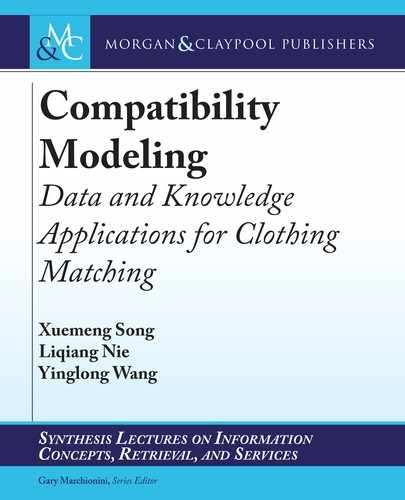
28 4. KNOWLEDGE-GUIDED COMPATIBILITY MODELING
Stripe Roll
Neck
Striped Midi
Skirt
White Striped
Crop Top
Skirt in Black
Stripes
(a) Example 1. (b) Example 2.
Figure 4.1: Illustration of the rule confidence on different item pairs. Both examples satisfy the
rule “stripe tops can go with stripe bottoms.”
Figure 4.1a and deserve higher rule confidence as compared to that of Figure 4.1b. Accordingly,
how to effectively assign the rule confidence is a crucial challenge.
To address the aforementioned challenges, we present a compatibility modeling scheme
with attentive knowledge distillation, dubbed as AKD-DBPR, as shown in Figure 4.2, which
is able to learn from both the specific data samples and the general domain knowledge. In par-
ticular, we adopt the teacher-student scheme [45] to incorporate the domain knowledge (as a
teacher) and enhance the performance of neural networks (as a student). As a pure data-driven
learning, the student network aims to learn a latent compatibility space to unify the fashion
items from heterogenous spaces with dual-path neural networks. To comprehensively model
the compatibility and the semantic relation between different modalities, the student network
seamlessly integrates the visual and contextual modalities of fashion items by imposing hid-
den layers over the concatenated vectors of visual and contextual representations. Moreover, to
better characterize the relative compatibility between fashion items, we investigate the pairwise
preference between complementary fashion items by building our student network based on
the BPR framework [100]. Meanwhile, we encode the domain knowledge with a set of flexible
structured logic rules and encode these knowledge rules into the teacher network with regular-
izers, whereby we introduce the attention mechanism to attentively assign the rule confidence.
Ultimately, the student network is encouraged to not only achieve good performance of the
compatibility modeling but also emulate the rule-regularized teacher network well.
4.2 RELATED WORK
4.2.1 COMPATIBILITY MODELING
As mentioned in Chapter 3, increasing research attentions have been paid to the fashion domain,
especially the compatibility modeling between fashion items [31, 67, 86, 108] in fashion analysis.
Overall, existing studies mainly focus on modeling the compatibility purely based on the data-
driven deep learning methods but overlook the value of domain knowledge. Distinguished from
..................Content has been hidden....................
You can't read the all page of ebook, please click here login for view all page.
